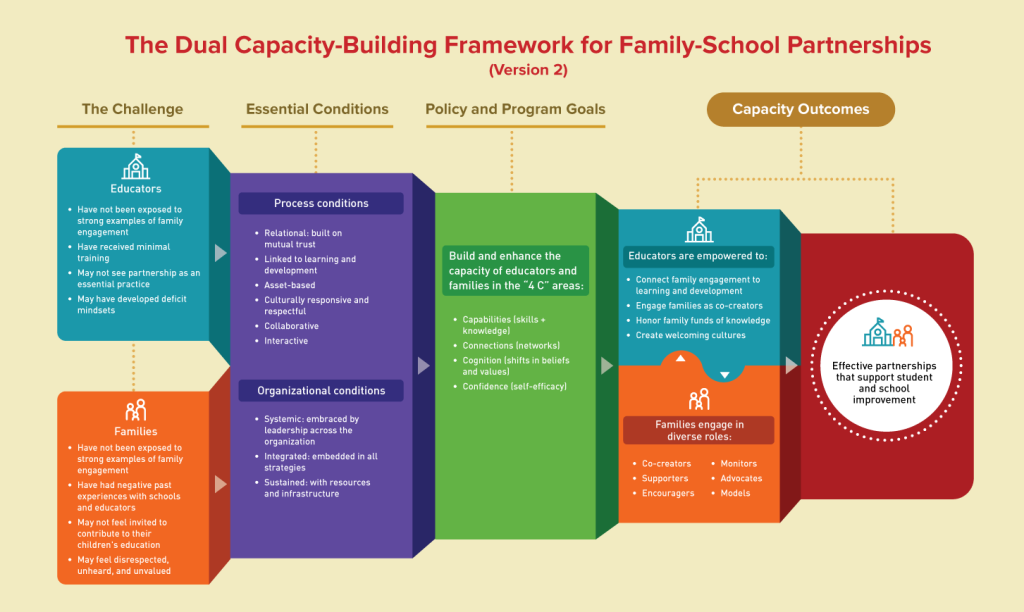Dual Capacity Building Framework
Hoover-Dempsey & Sandler Model of Parental Involvement Process
Family engagement models begin by asking three primary questions:
- Why do (and don’t) families become involved with their childrens’ communities and schools?
- What do families do when they are involved?
- How does family involvement make a positive difference in child outcomes?
These questions serve as the foundation to the Hoover-Dempsey and Sandler model of parent involvement (1995, 1997):
Hoover-Dempsey and Sandler’s model is broken up into 5 levels leading from the caregivers’’ motivators, perception of invitation to be involved, and life context variables up through student achievement. It outlines the role that caregiver involvement plays in modeling collaborative relationships with schools and communities for children so that student achievement is impacted positively. The model suggests that caregivers’ involvement is motivated by
- how the caregiver involvement role is constructed and
- if the caregiver has a sense of efficacy for helping the child succeed in school.
Level 1
| Personal Motivators | Parent’s Perception of Invitations to be Involved | Life Context Variable |
|
|
|
Caregiver motivators are central to Level 1. It asks us to centralize the idea that the caregiver wants the child to succeed and is seeking opportunities to support them. It identifies outreach and invitation from the school or teacher as key components for involvement. Hoover-Dempsey and Sandler did not directly link that outreach and invitation to the cultural capital of the family. However, when we create that theoretical extension, we honor the caregivers’ demands of work and personal life on the time and energy balance for relationship formation between the caregiver and school/teacher.
Level 1.5
| Parent Involvement Forms |
|
The invitation is the focus of Level 1.5. Successful caregiver involvement forms when home/school communication reflects the goals, values, expectations, and aspirations of both the caregiver and the teacher/school. It assumes that involvement is a result of effective communication between the caregiver and school/teacher and that both the home and school activities are honored in that communication exchange.
Levels 2 & 3
| Learning Mechanisms Used by Parents during Involvement Activities |
|
| (Mediated by) Student Perceptions of Learning Mechanisms Used by Parents |
|
Level 2 looks at how caregivers are involved. It identifies four primary actions: encouragement, modeling, reinforcement, and instruction. Effective caregiver and school/teacher communication offers transparent recruitment into relationship formation by clarifying “how” so that caregivers can balance their time commitment with responsibilities and also best use their talents and abilities to support the child and the relationship to the school/teacher. The “how” is mediated by the child’s perception of the involvement.
Level 4
| Student Attributes Conducive to Achievement |
|
Level 4 focuses on the child. It assumes that the child will develop both social and academic self-efficacy, intrinsic motivation, and self-regulatory behaviors that are influenced by Levels 1 through 3. Level 4 assumes that effective caregiver and school/teacher collaborations result in a well-supported child who demonstrates student achievement in Level 5.
| Student Achievement |
It is important to note that the Hoover-Dempsey and Sandler model does not put full responsibility for parent involvement on the parent. It calls into question how parent involvement is defined by a school or community and how parents are invited or recruited to be involved. For example, if schools and communities do not honor funds of knowledge, equitable processes, cultural humility, and trust, then movement from Level 1 to Level 2 will not be achieved. Furthermore, in order to achieve family engagement, this model helps us to outline, in Level 1.5, the critical role of the design of family learning and parent involvement activities.
Pause to Reflect!
Discuss the following questions.
- Review Level 1.5 of the Hooper-Dempsey Sandler model.
- What factors must a school or community consider when designing parent/teacher/school communications?
- What factors must a school or community consider when designing parent involvement or family learning activities?
- Design a Family Engagement event that will be hosted at a school, hospital, or community center. Family and Community Engagement may be a useful article for you to review:
- Describe your event. Who is the target audience? What is the purpose? Where will it be held? When and at what time will it be held? Will you invite representatives from the micro- or meso- systems outlined in Bronfenbrenner’s Ecological Theory?
- Develop a promotional flier for your event that demonstrates your understanding of funds of knowledge, equitable processes, cultural humility, and trust.
Case Study (A)

You are in your second year of teaching English Learners at a Massachusetts charter school and have been invited to join the ELPAC as a teacher representative. You attend the first two meetings and are surprised that there are no caregiver representatives at the meetings.
You learn that the school has tried, unsuccessfully, for two years to launch a successful ELPAC. It has tried to recruit caregivers via email and phone calls. It has planned in-person and Zoom-based meetings. It offers bilingual facilitators and translators. However, because there have been many staffing changes since the height of the COVID-19 pandemic, there has been inconsistent outreach and leadership.
You value the input and advice of caregivers and are committed to making the ELPAC successful. You decide to develop a strategic action plan to improve the ELPAC.
Review the definitions of Parent Involvement, Family Engagement, and Family Learning and apply those concepts to your strategic plan.
Using the Hoover-Dempsey and Sandler model, along with theoretical extensions of the definition of family, cultural capital, and inclusivity, what new strategies will you bring to your leadership team?
Dual Capacity-Building Framework
The Dual Capacity-Building Framework was originally developed by Dr. Karen Mapp in 2013 to describe the objectives and conditions that are essential for effective family-school engagement and collaboration.
The Framework builds on existing research suggesting that partnerships between home and school can only develop and thrive if both families and staff have the requisite collective capacity to engage in partnership. Many school and district family-engagement initiatives focus solely on providing workshops and seminars for families on how to engage more effectively in their children’s education. This focus on families alone often results in increased tension between families and school staff. Families are trained to be more active in their children’s schools, only to be met by an unreceptive and unwelcoming school climate and resistance from district and school staff to their efforts for more active engagement. Therefore, policies and programs directed at improving family engagement must focus on building the capacities of both staff and families to engage in partnerships (Mapp & Kuttner 2013).
In 2019, the Dual Capacity-Building Framework was updated to Version 2 to include Mapp’s collaborative research with Marissa Alberty, Eyal Bergman, and the Institute for Educational Leadership. Its foundational philosophy underpins the belief that successful engagement requires both educators and family members to develop essential beliefs, knowledge, skills, confidence, and social relationships that are bound to a shared understanding of funds of knowledge, equitable processes, cultural humility, and trust. While the framework is focused on partnerships between educators and families, it does provide useful guidance for partnerships between educators and youth or between schools and community organizations.
The Dual Capacity-Building Framework for Family-School Partnerships (Version 2)

The Dual Capacity Framework builds upon four interrelated categories:
- The Challenge helps us understand the reasons why educators and families have struggled to build trusting and effective partnerships.
- Educators: The framework assumes that educators have not been exposed to strong examples of family engagement and have received minimal training in this area. As such, they may not understand “partnership” and may approach families from a deficit-based model.
- Families: The framework assumes that families are not considered true “partners” in most educational institutions. Therefore, families may feel disrespected, unheard, and unvalued, resulting in negative experiences with schools.
- The Essential Conditions offer research-based guidance for best practice to cultivate and sustain partnerships. Our capacity-building process must be relational, asset-based, culturally sustaining, collaborative, and interactive. Finally, it must link to learning and development. We must foster organizational conditions that are systematically supported by leadership and aligned with strategic initiatives. Those conditions must also be sustained via resources and infrastructure.
- Policy and Program Goals highlight the goals and outcomes that should emerge for educators and families when the Essential Conditions are met. This area of the dual capacity-building framework builds and enhances the capacity of educators and families. It seeks to reinforce and honor a shared understanding of
- Capabilities
- Connections
- Cognition
- Confidence
- Capacity Outcomes show how improvements in capacity lead to educators and families working in mutually supportive ways, leading to student and school improvements.
- Educators engage families through culturally sustaining strategies that honor cultural capital and funds of knowledge. Educators connect family engagement to learning and development and create welcoming school climates and cultures.
- Families co-create learning activities and advocate for the needs of their children in partnership with educators. They support the work of the school and of the educator, thereby impacting student support and school improvement.
Pause to Reflect!
Discuss the following questions.
- Review The Challenge as described in the Dual Capacity-Building Framework for Family-School Partnerships (Version 2).
- Interview an educator about their understanding of family engagement. What training have they received in this area? Do they approach family engagement as an equitable process? Do they approach family engagement from a strengths- or deficit-based process?
- Interview a family of a child who attends school about their relationship with the school. Have they been invited to contribute to their child’s education? What opportunities or barriers exist for them to collaborate with the school?
- Do those interviews support or negate the assumptions made in the Dual Capacity-Building Framework?
Media Attributions
- Woman lecturing in group © Photo by Antenna on Unsplash is licensed under a Public Domain license
- Dual Capacity-building Framework © Dual Capacity is licensed under a CC BY-NC-SA (Attribution NonCommercial ShareAlike) license

